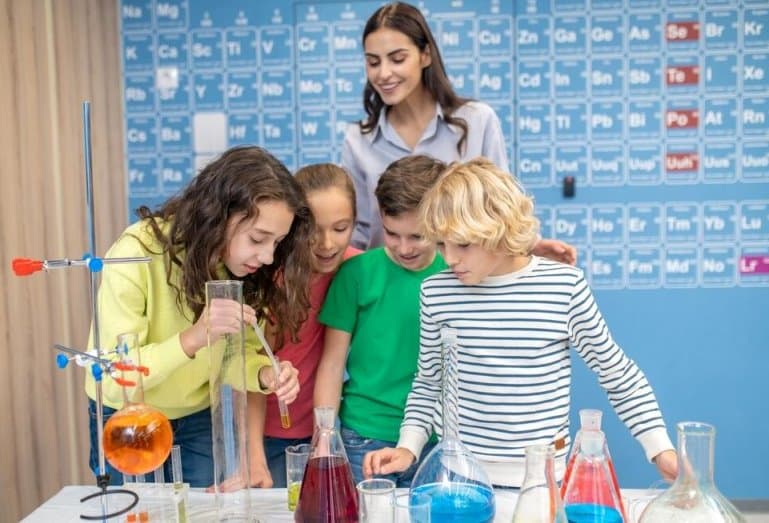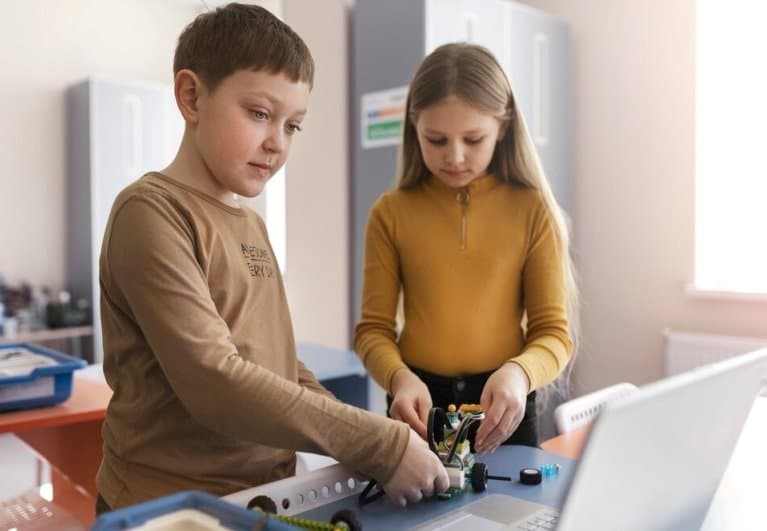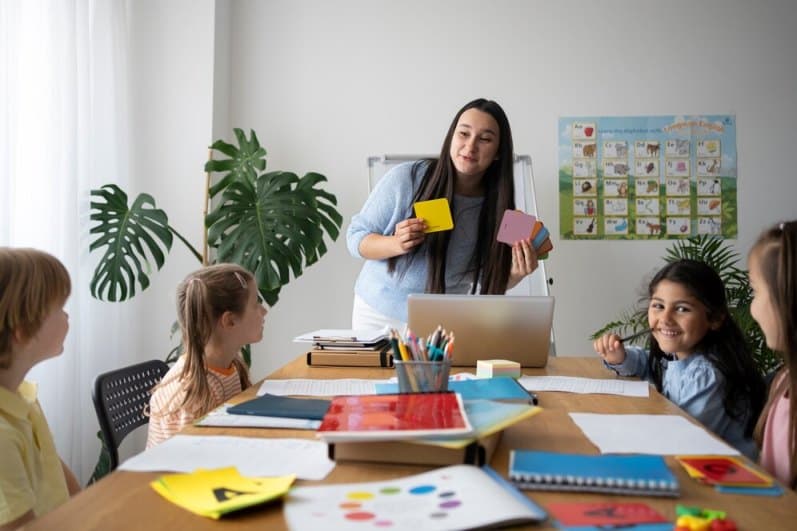To make science interesting for high school students, incorporate hands-on experiments and relate lessons to real-life scenarios. Use engaging visuals and interactive technology to maintain their interest.
Science can sometimes feel daunting for high school students. Engaging teaching methods can transform this perception. Hands-on experiments allow students to see theories in action, making abstract concepts concrete. Relating lessons to real-life scenarios helps students understand the relevance of what they are learning.
Engaging visuals and interactive technology can captivate students’ attention and make complex topics easier to grasp. By incorporating these strategies, educators can foster a more dynamic and stimulating learning environment. This approach not only makes science more interesting but also encourages students to develop a deeper curiosity and passion for the subject.
In this article, we will discuss various strategies to make science not only approachable but also fascinating for high school students. These methods will spark curiosity, enhance understanding, and build lasting interest in the subject.
Engaging Experiments
Students love hands-on activities. These activities make learning fun. They also make it interactive. For example, mixing baking soda and vinegar can show a chemical reaction. Students can see bubbles and fizz. This makes science come alive. They can also build small electric circuits. This helps them understand electricity.
Creating a volcano model with clay and baking soda is exciting. It shows a real-world phenomenon. Using microscopes to look at cells is another great activity. These activities engage the senses. They keep students interested.
Science is all around us. Real-world applications help students see this. For example, learning about photosynthesis can be linked to gardening. Understanding gravity can be linked to sports. This makes science feel relevant. It shows how science affects daily life.
Discussing current events can also help. For example, talking about climate change. This helps students see the importance of science. Using technology like simulations can make lessons more engaging. This keeps students curious and motivated.
Interactive Learning Tools
Educational apps can make science fun. These apps use games and puzzles to teach. They offer interactive lessons that keep students engaged.
Many apps provide instant feedback on quizzes. This helps students learn quickly. Some apps even have augmented reality features. These features bring science concepts to life. Students can see 3D models of planets and cells. This makes learning exciting and memorable.
Virtual labs allow students to perform experiments online. They can mix chemicals and see reactions safely. These labs are cost-effective and accessible. Students can use them anytime and anywhere.
Virtual labs often include step-by-step instructions. This makes it easy to follow along. They also offer simulations that mimic real-life experiments. These simulations help students understand complex concepts. Virtual labs are a great way to explore science without a physical lab.
Storytelling In Science
Using historical narratives makes science engaging. Stories about famous scientists capture attention. Students love tales of discovery and adventure. Talking about Galileo or Marie Curie makes lessons exciting. Real-life drama in science boosts interest. Students remember stories better than facts.
Science fiction links science to imagination. Discussing movies like Star Wars excites students. They see science in a fun context.
Books like The Martian show science in action. Fiction sparks curiosity about real science. Students explore scientific principles through stories. This method makes learning science enjoyable.
Guest Speakers
One effective method to make science more engaging is by inviting guest speakers who work in scientific fields. When students hear from professionals like environmental scientists, engineers, or medical researchers, they get a clearer understanding of how science is applied in real-life careers.
This exposure can broaden students’ horizons, showing them the diverse paths a career in science can offer, from space exploration to developing new medical treatments. Hearing these stories from people working in the field can inspire students to pursue further study and motivate them to engage deeply with the subject.
Field Trips
Science museums offer a hands-on learning experience. Students can see real-world science exhibits. These exhibits make learning fun and engaging.
Interactive displays help students understand complex topics. Many museums also have live demonstrations. These demonstrations show science in action. Students can ask questions and get direct answers.
Nature reserves are great for learning about ecology. Students can observe animals in their natural habitat. This helps them understand biodiversity. Guided tours provide information about different species. Nature walks can teach about plant life and ecosystems. The experience of being in nature can spark a love for science.
Project-based Learning
Group projects can make science fun. Students work together on shared goals. Each student has a role in the project. This helps them learn cooperation.
They also learn to share ideas and solve problems. Working in groups can make big tasks easier. It also helps students enjoy science more.
Individual research allows students to explore their own interests. Each student picks a topic they like. They then study it deeply. This can make learning more enjoyable.
Students take pride in their work. They also develop research skills. These skills are useful in many subjects. Encouraging students to present their findings can boost confidence. It also helps them practice communication skills.
See Also: Advantages And Disadvantages Of Using Tablet In The Classroom
Integrating 3D Printing
3D printing is an innovative technology that can revolutionize the way students engage with science. By incorporating 3D printing into the curriculum, educators can provide a tangible, hands-on learning experience that enhances understanding of complex concepts.
For instance, in biology, students can print detailed models of cells, organs, or even DNA structures. These physical representations help students visualize and comprehend the intricate parts of living organisms that might otherwise be difficult to grasp through textbook images alone.
In chemistry, 3D printing allows students to create molecular models, enabling them to explore atomic bonding and molecular shapes in a more interactive way.
In physics, 3D printers can be used to design and build prototypes, like catapults or simple machines, which students can test and refine. This not only strengthens their grasp of theoretical principles like force and motion but also nurtures engineering skills such as design thinking and problem-solving.
The real-world applications of 3D printing further emphasize its importance. By introducing students to this technology, educators can highlight its growing role in industries such as medicine, aerospace, and manufacturing.
For example, students can study how 3D printing is used to create prosthetics or custom parts for machinery, bridging the gap between classroom learning and professional practice.
Gamification Techniques
Science quizzes can make learning fun. They can be multiple-choice or true/false. Students can play these quizzes in teams. It helps them learn and compete. Quizzes can cover different science topics. This way, students get a broad understanding.
Educational games can make science exciting. Games like puzzles or simulations teach science concepts. For example, a game about planets helps students learn about space. These games can be played on computers or tablets. They make learning feel like playing. This keeps students engaged and eager to learn more.
Using Multimedia
Documentaries can spark curiosity in students. They bring real-world science into the classroom. Students get to see scientific concepts in action. This makes learning more engaging and memorable. Choose documentaries that are fun and educational. Ensure they are appropriate for high school students. Give a short quiz after watching. This will help reinforce learning.
Interactive simulations allow students to experiment in a virtual lab. They can test theories without any risk. This hands-on approach keeps students engaged.
Simulations can explain complex concepts easily. They provide immediate feedback, which helps in quick learning. Use simulations that align with the curriculum. This will ensure they are educational.
Conclusion
Science is a subject that holds endless possibilities for discovery and innovation. By utilizing interactive experiments, real-life connections, technology, storytelling, and collaboration, educators can transform how students perceive and engage with science.
These methods help create an environment where curiosity is encouraged, making science both interesting and accessible to high school students.




